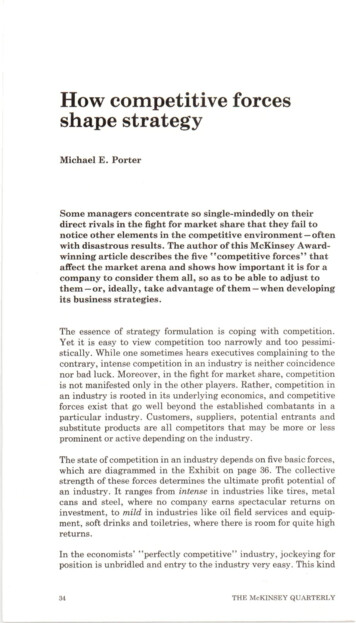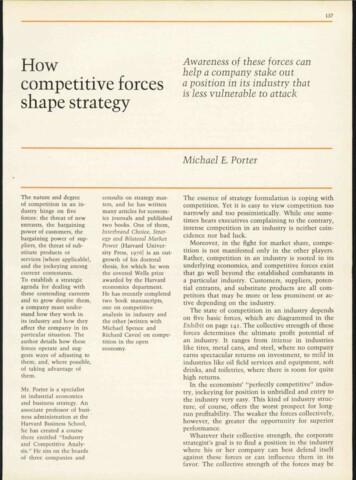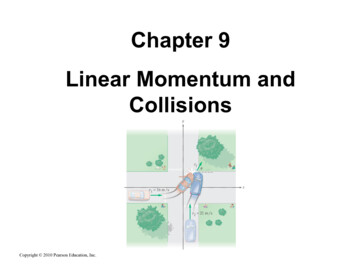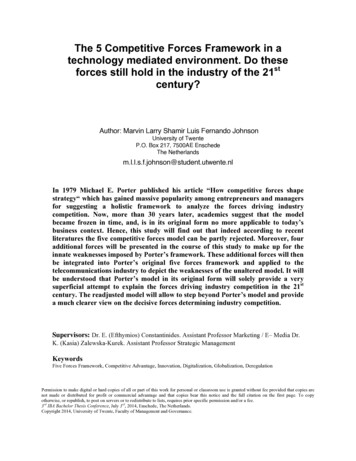
Transcription
The 5 Competitive Forces Framework in atechnology mediated environment. Do theseforces still hold in the industry of the 21stcentury?Author: Marvin Larry Shamir Luis Fernando JohnsonUniversity of TwenteP.O. Box 217, 7500AE EnschedeThe Netherlandsm.l.l.s.f.johnson@student.utwente.nlIn 1979 Michael E. Porter published his article “How competitive forces shapestrategy“ which has gained massive popularity among entrepreneurs and managersfor suggesting a holistic framework to analyze the forces driving industrycompetition. Now, more than 30 years later, academics suggest that the modelbecame frozen in time, and, is in its original form no more applicable to today’sbusiness context. Hence, this study will find out that indeed according to recentliteratures the five competitive forces model can be partly rejected. Moreover, fouradditional forces will be presented in the course of this study to make up for theinnate weaknesses imposed by Porter’s framework. These additional forces will thenbe integrated into Porter’s original five forces framework and applied to thetelecommunications industry to depict the weaknesses of the unaltered model. It willbe understood that Porter’s model in its original form will solely provide a verysuperficial attempt to explain the forces driving industry competition in the 21stcentury. The readjusted model will allow to step beyond Porter’s model and providea much clearer view on the decisive forces determining industry competition.Supervisors: Dr. E. (Efthymios) Constantinides. Assistant Professor Marketing / E– Media Dr.K. (Kasia) Zalewska-Kurek. Assistant Professor Strategic ManagementKeywordsFive Forces Framework, Competitive Advantage, Innovation, Digitalization, Globalization, DeregulationPermission to make digital or hard copies of all or part of this work for personal or classroom use is granted without fee provided that copies arenot made or distributed for profit or commercial advantage and that copies bear this notice and the full citation on the first page. To copyotherwise, or republish, to post on servers or to redistribute to lists, requires prior specific permission and/or a fee.3rd IBA Bachelor Thesis Conference, July 3rd, 2014, Enschede, The Netherlands.Copyright 2014, University of Twente, Faculty of Management and Governance.
21. INTRODUCTION: A MODEL THATSEEMS TO HAVE BECOME FROZEN INTIMEIn the year of 1979 a framework was introduced thatshould turn the entire way around how managers andentrepreneurs view the competitive environment, in which afirm in a specific industry is embedded in. The model is mostwidely known as Porter’s forces model (Porter, 1979). Sincethen Porter’s model was considered to be the ultimate tool todiscover the forces that drive industry competition. It is handy,it is quick to use and, most importantly, it is easy to understand.The model basically aims at describing the competitiveenvironment a firm is embedded in along five industry-specificfactors that drove to Porter’s mind industry competition (Porter,1979). Despite that, in recent years, these forces have massivelycome under fire. Some researchers argue that the model has aninnate weakness, and, besides this, is difficult to operationalize(Lee, Kim, & Park, 2012). Other researchers, on the contrarystate that the model does not take into account a firm’s potentialcollaborative relations with determinants of the industryenvironment (Dulčić, Gnjidić, & Alfirević, 2012). Grundy(2006) even said that it seems as if the once so popular forcesmodel has become frozen in time. This gives rise to thequestion if Porter’s five forces are still holding in today’scompetitive environment and, hence, if these forces still definemodern industry competition. As the environment changes, sodoes the industry and also the firms that react according to thechanges imposed by the changing environment and industry.And this is exactly where this paper draws on.This paper aims at providing an in-depth literaturereview of the latest findings on Porter’s competitive forcesmodel. It will answer the question whether the five forcesframework should be accepted, partly rejected, or probablyeven fully rejected in today’s business context. This, in turn,will be facilitated by firstly introducing the reader to the fiveforces framework and informing him what it is basically about.Afterwards, the latest thoughts and findings on alterations toPorter’s framework will be identified. These findings will eitherconstitute whole new approaches, which will serve as substituteapproaches to Porter’s model, or approaches that go beyondMichael E. Porter’s framework by adding additional forces to it.From there, this paper will overflow to empirical work that isderived from the findings made earlier in this paper. Here, thisstudy will take a closer look at the telecommunication industrywith the case study of Apple, HTC, Google and many otherimportant players from the telecom industry. The case studywill then allow to comprehend a new conceptual frameworkthat is specifically designed for application in the high-techindustry. Augmenting the existing five forces framework willallow to solve the research problem of the ever growingcompetition in the telecommunication sector in recent years.Laffont and Tirole (2001, p. 1) mention this dilemma in theirbook ‘Competition in telecommunications’ by saying that“competition in the telecommunication has developed fasterthan in other industries.“ Hence many firms operating in thisindustry struggle to gain competitive advantage and this iswhere this paper sets in.The research problem will be solved along the courseof this study by finding an answer to the following threeresearch questions:To what extent do Porter’s Five Forces alone drive industrycompetition in large multinational companies operating in thetelecommunication industry?To what extent are the factors globalization, deregulation,digitalization and innovation relevant to driving industrycompetition?To what degree do the factors globalization, deregulation,digitalization and innovation show applicability in businesspractice?2. A SNEAK PREVIEW INTO THE FIVECOMPETITIVE FORCESPorter defined five distinct forces that have to bethought of when determining the attractiveness of a certainindustry. Attractiveness, at this point, refers to the profitabilitythe industry offers its entrant. According to the profitability itshould then be thought about if entering the industry isreasonable or should be avoided. The stronger these five forcesare the less profit can be achieved in this specific industry and,hence, the less attractive this industry is to its potential entrant(Porter, 1979).The five competitive forces are constituted by thethreat of new entrants, the bargaining power of buyers, thebargaining power of suppliers and the threat of substituteproducts or services.The threat of new entrantsPorter considers the threat of new entrants in a givenindustry as a vital factor in determining industry profitabilityand attractiveness. He assumes six major sources of barriers toindustry entry exist (Porter, 1979).Here, the factors of economies of scale, product orservice differentiation and capital requirements do constitute themain areas of attention when estimating the threat of newentrants (Porter, 1979). In some industries, huge economies ofscale play a role in order to enter the industry, while in otherindustries more product or service differentiation leads toregulate the threat of new entry. Other industries such as thepharmaceutical or automotive industry require huge amounts tobe invested for instance in product machinery before any profitscan be derived. Hence, Porter (1979) sees this aspect as adriving force for industry competition.Bargaining power of buyersThe bargaining power of buyers is the level to whichbuyers can exert power on participants in an industry. This canhappen through various ways such as force down prices,demand higher quality and play competitors off against eachother (Porter, 1979). Among the most well known factors ofpower that buyers can exert on industry participants is thepurchase volume and the level of product or servicedifferentiation (Porter, 1979, 2008).Bargaining power of suppliersThe bargaining power of suppliers, on the other hand,is the level to which suppliers can exert power on participants inan industry. Suppliers can exert power on firms operating in aspecific industry by knowing that there are no fallback suppliersto which firms can shift, when buyer and supplier share thesame production facilities or have other co-operations withsuppliers that bind them to one specific supplier (Porter, 1979).
3Threat of substitute products or servicesThe threat of substitute products or services isbasically described as the level to which products or servicesare exchangeable with other products or services in the sameindustry (Porter, 1979). The easier it is for the prospect to findsubstitutes to ones offered products or services the harder it isfor an entrant to position himself in an industry and, hence,generate profits (Porter, 1979, 2008).Rivalry Among Existing CompetitorsKnowing the preceding four factors it can be nowarrived at the final force, which is according to Porter (1979)the rivalry among existing competitors. The stronger thesepreceding forces interact the stronger the rivalry among existingcompetitors will be. Porter (1979, p. 7) also refers to this forceas the “jockeying for position“ as this force is mainly aboutusing tactics such as price competition, advertising slugfestsand product innovation in order to assume a fixed position inthe industry.In summary, Porter (1979) assumes these five forcesto be applicable to absolutely every industry, regardless of if itis low-tech, or high-tech, emerging economy or developedeconomy (Porter, 2008) and sees them as a vital key todetermining industry trends, profitability and attractiveness.3. METHODOLOGYHaving discussed Porter’s underlying forces in thepreceding paragraph the reader will now be given anunderstanding of how this paper will be structured. At the sametime, the line of reasoning will be provided that this paperemploys in order to find an answer to the aforementionedresearch questions and arrive at a sound conclusion.In the first instance, this paper will go on withproviding an insight on recent academics and what they think ofPorter’s competitive forces framework. Here, one will beintroduced firstly to variations that have been made to theoriginal five forces framework that can be derived from threedifferent schools of thought. After that it will be arrived at atrend. The paper will secondly introduce whole new approachesbrought to the reader by academics who assume that neitherminor nor major alterations are enough in order to define theforces driving industry competition in the 21st century. The rawdata used is mainly gathered through internet-based searchengines like Scopus, Google Scholar or the Internet library ofthe University of Twente, but at the same time searchingthrough offline libraries. Not least Downes (1997) articlereviewing the five forces framework critically is foundsearching offline libraries. Subsequently the literature found berelevant will be analyzed. After that, the relevant articles areentered a literature matrix (see Table 1a and 1b). The top rowsrightwards display the different categories of intellectualapproaches towards Porter’s five forces framework, which arefound scanning through the articles while the first columndownwards lists the different authors belonging to one of thesecategories. The various categories are formed by readingthrough each article and entering their intellectual approach asnew category. Whenever a new approach is observed it isinstantly entered in the matrix. Likewise, whenever authorswhere found to come up with the same intellectual approachthey were assigned to the same category. The paper holds twosuch matrices. One holds the information for the alterations orvariations to Porter’s framework, while the other one holdsinformation on the new approaches towards the five forcesframework. This is done in order to observe trends more easilyand independently. The relevance of an article is mainlydetermined looking at the paper’s abstract and conclusions.Whenever these are found to be appealing an in-depth analysisis applied by reading through the whole paper. The year ofpublication also plays a role as articles have to be moderatelynew in order to provide a sound message on the topicality ofPorter’s five forces. Following this manner every article isjudged independently if it should be incorporated in this studyor not. In total, 54 articles are used for this study. Elevenarticles are used to discuss the common alterations to Porter’smodel ranging from minor to major alterations to his model. 21articles are used to present new surrogating approaches to thefive forces approach. These 21 articles, in turn, allow to arriveat 10 articles which propose innovation to be the main forcedriving industry competition, 11 articles which suggest theresource-based view to drive industry competition and 6 articlesthat assume other forces to drive industry competition. Thisprovides 27 entries into the matrix other than the 21 articlesmentioned in the beginning. This is because 6 double-entriesexist where an article is attributed to both the resource-basedview and the innovativeness as force driving industrycompetition. Lastly, the remaining 22 articles focus on eitherPorter’s own comments on his framework, literature thatsupports the effect of shorter product life cycles on a firm’sinnovativeness or articles that deal with the analysis of varioustelecommunication industries around the globe.The key search terms to find relevant articles areprimarily ‘competitive advantage’, ‘innovation’, ‘globalization’,‘deregulation’, ‘digitalization’, ‘innovation’ but also ‘fiveforces’, ‘industry competition’ and ‘competition’. Entering thesearch term ‘competitive advantage’ in Google Scholarprovided 2.700.000 results, while 96,719 results could beretrieved checking the University of Twente online library.Science direct gave 240,605 hits. From the articles, which werethought to be relevant the bibliography was checked in order tofind useful cross-references to discover even more meaningfularticles.An often times discussed article is the one of Downes(1997). Downes is well-known for his book called ‘Unleashingthe killer app: Digital strategies for market dominance’ andsuggests in one of his articles three forces driving industrycompetition which surrogate the five competitive forces model.These are globalization, deregulation and digitalization(Downes, 1997).Moreover, the level of innovativeness will gain a lotof attention in this study as this paper will point out itsimportance as force driving industry competition. This will ofcourse come along with many authors backing this assumptionup. Accordingly, this paper will recombine the knowledgegained from the literature review to come up with one holisticframework that makes up for Porter’s shortcomings of the fiveforces model. The new forces being relevant will beoperationalized and further explained to the reader. On top ofthat, it will be explicitly explained why these specific forcesshould be taken into consideration. A figure will follow toillustrate at a first glance which line of reasoning was followedto arrive at the forces neglected by the five forces framework.After that, the paper will be concluded by taking acloser look at the telecommunication industry. Here,mentioning the examples of Apple, HTC, Google, JuniperNetworks and many other important telecom players willfacilitate a greater understanding of the new frameworkpresented in this paper by applying it to the case of theaforementioned organizations.
4In the end of this study, the reader will be introducedto a discussion and limitations section. In this section, thereader will critically reflect on the findings made in this paperwhile at the same time catching a glimpse at the variouslimitations the paper comes along with. Having understood thelimitations the paper will be ultimately ended with theconclusion. Here, all findings made throughout this study willbe summarized, which, in turn, will provide food for thoughtfor future research.4. LITERATURE REVIEW4.1 A round-up of common criticismsIn order to provide a better understanding of thefollowing opinions of academics on the model this paper willdistinguish between three schools of thought. The first school ofthought will be comprised of academics who only see minoradjustments to the model as necessary. Here, Porter’s forceshave only been summarized or grouped. No changes have beenmade to the model by adding or detaching forces of the originalmodel. The second school of thought consists of academics whosee a mediocre adjustment to the model as inevitable andrelevant. This explicitly means that adjustments to the fivefacets of the model have been taken place by the academic byreplacing forces completely or only keeping some of themunchanged. The last school of thought argues for majoradjustments to the model. Here, the whole model isreconsidered and/ or is combined with other models. Thisbasically means none of the forces are kept in their originalmanner.A relatively small number of researchers regard minoradjustments to the model as necessary. Slater and Olson (2002)propose an augmented model that only groups or summarizesPorter’s model in a new way. Slater and Olson (2002, p. 16)argue that none of the forces should be removed. They simplyrestructure the model by for instance, combining substitutes andthreat of new entry into a single category to which they refer toas “composite competitive rivalry force”. The vast majority ofacademics, however, see an either mediocre or majoradjustment to Porter’s five competitive forces approach asprerequisite. Dulčić et al. (2012, p. 1077) believe that “the fivecompetitive forces model should be modified for assessingtoday’s dynamic industry structure.“ Dulčić et al. (2012)introduce the dimension of time dynamics, which to theiropinion enables managers to get a clearer glimpse in theexistence of past, present and future interactions between theindustry environment and firms which are embedded in it.Another mediocre adjustment to the model is presented byBreedveld, Meijboom, and de Roo (2006). Breedveld et al.(2006) assume Porter’s model cannot be applied to not-forprofit organizations as the structure of the forces look somewhatdifferent in this sector and, hence, is not applicable to everyindustry opposed to the assumptions of Porter (1979). Hence,Breedveld et al. (2006) modify the determinants of thebargaining power of labor suppliers in order to make itapplicable to the home care industry. Nevertheless, the otherfour forces are kept in their original way. Maxfield (2008)assumes mediocre adjustments to the model to be made bymaking Porter’s model more compatible with corporate socialresponsibility than with approaches resting on neoclassicalequilibrium models of firm performance. So one can obviouslysee that ideas on the adjustment of Porter’s model come fromvarious perspectives. Surprisingly, most literature found thatmajor adjustments to the model are needed. Lee et al. (2012)assume that the five forces framework has an innate weaknessand is difficult to operationalize. Hence, it should not enjoypopularity anymore. Alternatively, an analytic network process(ANP) approach is provided to overcome Porter’s model andtherewith make up for its weakness and difficulty inoperationalization (Lee et al., 2012). The same approach isemployed by Wu, Tseng, and Chiu (2012) who also see theANP approach as a perfect substitute to Porter’s five forcesframework. Other approaches see the Toulmin method as anoutstanding substitute to Porter’s obsolete model as the validityof Porter’s model is questionable (Narayanan & Fahey, 2005)while again other authors regard the Delta-Method asappropriate substitute to the competitive forces framework todescribe the forces driving industry competition (Hax & WildeIi, 2001). Nevertheless, two specific literatures have gainedmassive popularity among Porter contestants, which is on theone hand Tony Grundy’s article “Rethinking and reinventingMichael Porter’s five forces model. Strategic Change“ andLarry Downes (1997) published article “Beyond Porter“. WhileGrundy’s article focuses more on the background of each of thefive forces and, hence, derives so-called micro-forces from theoriginal five forces, Downes’ article basically comes up withthree additive forces, which are globalization, digitalization andderegulation (Downes, 1997). These three forces have gainedmassive popularity among researchers who argue against thefive forces framework, and, is at the same time also able to bequickly applied to any industry of choice. This is why, thispaper will further elaborate on these three forces in the courseof this study. Beyond that, this paper provides with Fig. 1 anoverview of the three different schools of thought, showing thatamong the eleven most trending literatures already seven haveconsidered that major adjustments to the model have to be madein order to make the model applicable to today’s businesscontext. Only a minority of trending articles saw eithermediocre or minor adjustments to the model as enough to makethe model applicable to today’s business terations/adjustments to Porter’s model over the three distinctschools of thoughtIn addition to the different alterations to Porter’smodel we have discussed in the previous section one should notdisregard that also whole new approaches to strategic thinkingand, hence, the definition of the forces driving industrycompetition have emerged. For this purpose a more holisticview has been employed by focusing thoroughly on what otherresearchers have so far found to drive industry competitionregardless from Porter’s five forces. At this point, it isimportant to note that this paper has a narrow focus on the hightechnology industry in the form of the telecommunicationindustry. This is why it might be very interesting to check whatother researchers have thought to be a force that is inevitable totake into consideration when thinking in high-tech terms.
5Unlike the previous section where different schoolsof thought were presented showing the trend that mostresearchers suggest that a major adjustments to Porter’s modelshould be made, clearer trends can be observed when taking alook at the factors driving industry competition in the high-techindustry or more specifically the telecommunication industry.These trends assume the level of innovativeness to be a veryimportant factor. Earlier, innovativeness was only regarded asone of many resources a firm had, derived from the ideology ofthe resource-based view. Innovativeness was related to internalfactors, which aimed at obtaining competitive advantage.Nowadays, however, the level of innovativeness has turned outto be among the most important factors when thinking about theforces driving industry competition. It has become an externalfactor, which is to large extent affecting the industryenvironment. This assumption is further supported by Qiannan(2011, p. 382) who explicitly states that “innovative industrialclusters can promote the regional competitiveness. Therefore,the study of relationships between regional competitiveness andinnovative industrial clusters has become an important issue.“This statement should provide the reader with a first impressionhow inevitable innovativeness is in defining the driving forcesof industry competition. This is topped off by Bettis and Hitt(1995) who both assume that rapid technological changesundermine the sustainability of competitive advantage (Sirmon,Hitt, Arregle, & Campbell, 2010). This again fosters howimportant the concept of innovation is when thinking about theforces driving industry competition in an innovation-mediatedindustry as the telecommunication is. It is even gone a stepfurther by claiming that government policy makers facestrategic discontinuities, which are changing the nature ofcompetition due to technological change, make old tools for theassessment of the driving forces of industry competitionobsolete and form a whole new competitive landscape with newforces driving industry competition (Bettis & Hitt, 1995).Another research conducted for the U.S. car industry highlightsagain the importance of innovation and the loss of competitiveadvantage without it. Same as the telecommunication industrythe car industry also belongs to the high-tech industry whereresisting innovation that reduced pollution in the 1970’s led to aloss of competitiveness in the global economy (Porter & Vander Linde, 1995). A finding which Michael E. Porter himselfmade and, hence, obviously also let him believe that theconcept of innovation is inevitable in defining the forcesdriving industry competition for the high-tech sector. Lastly,very important contributions to research dedicated to the fieldof the forces driving industry competition have been made byLi and Vanhaverbeke (2009, p. 105) who found in their paper“The relationship between foreign competition, absorptivecapacity and pioneering innovation: an empirical investigationin Canada” that “the likelihood of pioneering innovationincreases when foreign competition continues to increase froma moderate to a high level.” This, again, pinpoints howimportant it is to take a firm’s level of innovation intoconsideration when formulating the forces driving industrycompetition. This is why this paper will also concentrate on theconcept of innovativeness as driving force for driving industrycompetition in combination with Downes’ proposed threeforces to provide the reader with an even better understandingwhich forces are needed to be implied to Porter’s original fiveforces framework to define today’s forces driving industrycompetition.4.2 Innovativeness as a firm’s main resourcecontesting the singleness of Porter’s 5 ForcesAs it has been made clear in the earlier section of thispaper innovation plays a tremendous role in gainingcompetitive advantage in an innovation-mediated industry and,hence, should be understood to be a force that also drivesindustry competition.Now a lot of research has not only been focusingsolely on innovation as a factor driving industry competition.Also the resource-based view, which found acceptance inacademics more than two decades ago seems to still play a roleup to today. According to Barney, Wright, and Ketchen (2001)the resource-based view on a firm aims to explain the internalsources of a firm’s competitive advantage. The resource-basedview proposes that if a firm is to achieve a state of sustainablecompetitive advantage it must gain or already hold resources orcapabilities of rare, inimitable and non-substitutable nature(Barney et al., 2001). Only if this state is given a firm canachieve sustainable competitive advantage. Rather than lookingat the position of a firm in a specific industry the resource-basedview claims to see competitive advantage and, thus, the forcesdriving industry competition in a firm’s internally heldresources. These internally held resources, in turn, can be foundin various forms among firms operating in a specific industry.Srivastava, Franklin, and Martinette (2013) propose a fewexamples by mentioning leadership, organizational culture,human capital management and design and culture to beresources that are embedded in the context of an organizationand, moreover, should be refined in order to gain competitiveadvantage. The assumption of human capital being among otherfactors a factor driving industry is also supported by Campbell,Coff, and Kryscynski (2012). Only a very few authors believethat factors driving industry competition are others than theresources being held by the firm. Examples here are forinstance, Reeves and Deimler (2011) who assumes that thelevel to which a firm can adapt to changes in an industry is aforce driving industry competition. The better one adapts to theindustry the more competitive advantage he will become, ishere the line of reasoning. Another supposition again is thateffective team management is driving industry competition(Aguinis, Gottfredson, & Joo, 2013). So what becomes clear isthat literature conveys many different ways of what researchersperceive to be the forces driving industry competition. Yet,going through academic literature a current trend is observable,which goes hand in hand with the findings we have discussed inthe previous section dealing with innovativeness and itsstrength to drive industry competition. Here, surprisingly a lotof linkages between the resource-based view and literatureperceiving that a firm’s innovativeness is a key driving force toindustry competition could be found. Camisón and Villar-López(2011) and Weerawardena and Mavondo (2011) believe thatboth learning capabilities and organizational memory foster theemergence of organizational innovation and marketinginnovation, which in turn has effect on sustained competitiveadvantage. What falls into place is that the concepts of theresource-based perspective and a firm’s innovativeness as amain force driving industry competition inseparably belongtogether as a firm’s innovativeness is also a resource a firmholds. Saqib (2011) sums it up nicely by declaring that theliterature is basically showing both, the views for the innovationand the competitive advantage but its moving towards theresourced based theories of management. This is once more thereason why the concept of a firm’s innovativeness should bestrictly included in the forces driving industry competition –especially in an innovation-mediated environment. In Fig. 2 thereader can again see the most trending articles dealing with the
6forces driving industry competition. What becom
In 1979 Michael E. Porter published his article "How competitive forces shape strategy" which has gained massive popularity among entrepreneurs and managers for suggesting a holistic framework to analyze the forces driving industry . understanding of how this paper will be structured. At the same time, the line of reasoning will be .

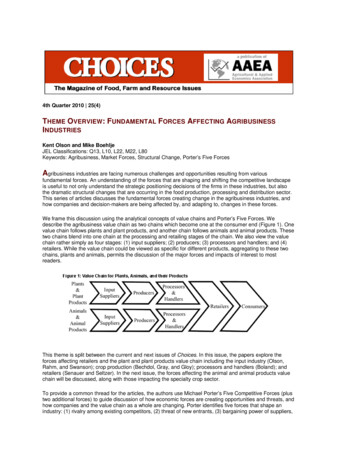

![05[2] Strategy competitors, competitive rivalry .](/img/2/052-strategy-competitors-competitive-rivalry-competitive-behavior-and-competitive-dynamics.jpg)
